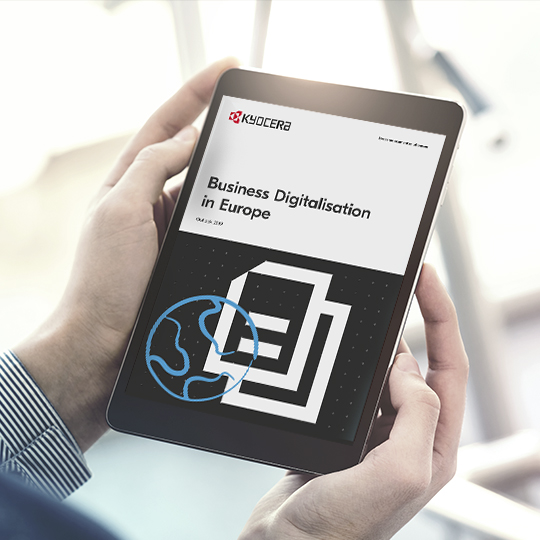What did our study Business Digitalisation in Europe Outlook 2019 reveal?
We asked Michael Powell, Expert Software Product Management at Kyocera Document Solutions Europe, to give us his perspective on the results of our investigation.
1. How would you define the area of content management?
Organisations have to handle enormous amounts of data. It is important to understand that all of this data has some kind of value. One could say that data is the new oil. Companies are starting to see that they have all this information and if they start looking deeper, they could get some real business insight, helping to analyse past and current business activity. This in turn can facilitate future decisions. This is where content management and document management come to play a vital role. Document Management Systems are systems that enable businesses to extract additional value from the content in their organisation.
2. What are the leading options for companies?
I would say that they are Enterprise Content Management, Document Management Systems and Content Services. I believe that the more technology a company adds, the better results it can achieve. The first reason to use content management systems is that they allow you to store your content in a structured format in a form of database. Then, a company might start to look at a business intelligence system, such as Document Management Systems or Content Management Solutions, which enable them to get additional data and help to create a foundation of content where professionals can connect additional technology to add further value. More technology can mean more results. However, companies should start off with a strategy defining what exactly they want to achieve. Just investing in a content management system is not automatically going to make a business more efficient. Clear goals have to be defined.
3. How can these solutions help businesses to face their challenges?
All companies want to save money and become more efficient. This is why it is important to trust a company who can find the optimal solution to minimise the costs and maximise the benefits. Depending on the business model and needs, the investment can be made through capital expenditure or operating expenditure, the latter meaning a monthly or periodic rate is paid. It is crucial to be aware of all of the options and to look for a strong partner that will help a company find the best fit solution.
4. According to Kyocera Document Solutions Europe’s Business Digitalisation in Europe Outlook 2019, 30% of businesses are not considering the integration of a content management system due to a lack of budget. Is there a need to educate the industry so that they will see a return on investment?
Yes, 100%. Businesses should be mature enough to realise that simply putting money into technology is not going to help them. However, once the goals are clear, the right technology to achieve the goals can be selected and results will become clear. The adoption of technology and the business strategy should always be coordinated. That is the key.
5. While the integration of content management solutions is an investment, in what ways can it help to reduce costs for businesses?
A good service provider will highlight all the advantages for cutting costs. For example, the reduction of costs for paper storage is worth underlining. Also, time is money, and Content Services and such technologies save businesses a lot of time by making processes more efficient. Valuable hours of work will be used more efficiently and office space will be used differently, all in more productive ways that can save money. Often firms forget to consider all of these invisible costs that play an important role when considering content management technology.
6. Are there any departments that can gain more from this technology? Or perhaps that are not yet adapting as quickly as they should be?
The area where we can usually see the quickest return on investment is where there is a high paper volume. Typically, this involves departments such as legal, logistics, transport, finance and procurement areas, as they usually have a high paper usage.
7. According to the Kyocera Document Solutions Europe’s Business Digitalisation in Europe Outlook 2019, three of the top six main challenges that businesses face are connected to paper. Would you say the future is paperless and that these solutions are the key?
I think systems such as ECM (Entreprise Content Management) and DMS (Document Management Systems) have a very important part to play, but large amounts of business content are still stored on paper. The next step for companies is to capture information from paper to the business system. Only then can Content Solutions be applied properly, as described earlier. Sadly, paperless is still far away, because even businesses that are very technologically advanced, such as mobile operators, have customers who are perhaps not mature with technology and still prefer paper.

8. Why do you think smaller companies are lagging behind when it comes to automation?
I believe there are two main reasons. Firstly, it is a question of budget, even though hosted cloud technology and similar services are becoming a lot more accessible. Secondly, and this is probably the major factor, companies are often not aware that they have a problem. They do not know that there are solutions that can make their processes a lot easier. This is why it is important for service providers to educate businesses about their possibilities.
9. Kyocera Document Solutions Europe’s Business Digitalisation in Europe Outlook 2019 found that 11% of companies stated they do not consider automation as a strategic goal in the near future. Do you think this is mainly due to a lack of education or could it be linked to user resistance?
I think the lack of education is the main reason. Automation is quite an ambiguous word, as it can be interpreted in many ways. However, if they are given concrete examples, let’s say they will now send their invoices via email, reducing manual work and postage fees, the idea of automation will not sound frightening anymore. It can be difficult to get employees to put their trust into a new system that they are unfamiliar with, but once it is broken down and explained properly, the advantages for everyone should become more evident.
10. Do you think a business could survive in the modern economy if they don’t adapt to these new technologies?
If we talk about survival, I think businesses will survive. However, they eventually have to start looking at ways to improve their work. Businesses that dare to consider new options will become more efficient. Those that don‘t do that will survive for now, but they will lag behind the competition. I feel that it is inevitable to eventually turn to technology.
11. What is the biggest challenge for the spread of this technology?
In the beginning, the major challenge will be to face the lack of knowledge about the systems and a lack of knowledge about companies’ own internal processes. The key is to educate businesses and demonstrate how they can benefit from this technology, and prove that it is accessible. Once the solution is acquired, the next big problem is resistance to change. It is key for companies to go through a proper change management process to highlight why the system is worth it and how it will help in achieving strategic targets and allow the company to be prosperous.
12. Looking at the Business Digitalisation in Europe Outlook 2019, it is surprising that some of countries with the most developed economies like Germany and the UK showed the lowest levels of automation and digitalisation. What are the challenges these countries are facing?
I think a part of the problem is resistance to change. There is a lot of early adoption in large organisations in developed countries. However, the rest of the market will be lagging behind. Also, vendors are often focused on the top end of the market, forgetting to help small and medium sized enterprises as well. I think the answer is a combination of resistance to change, lack of understanding and the belief that the technology is not accessible.
13. What do you think promotes the spread of the technology and its increased popularity?
I think it is a combination of technology becoming more accessible and cheaper, and the development of technology itself. Technology is changing. Artificial Intelligence and machine learning are making their way to workplaces. Innovations are becoming more accessible and people are showing interest and doing their research. We can observe millennials that grew up with technology entering the workplace, which is also a factor that will drive businesses to adopt more technology.
14. What are your predictions for the future in terms of automation and digitalisation?
We will see many early adopters going for the newest business technology, and this will be necessary to stay competitive. There will be more and more monitoring, resulting in an even further increase of business information, which will allow them to make better decisions.
15. What role will Kyocera Document Solutions Europe be playing in this transition?
First of all, we are aiming to take away the complexity of the topic. We want the users to understand that our solutions are accessible to them. Of course, we also want to highlight how adopting such solutions can add real value to businesses. We want to show it is a simple solution that can have great results. It can make businesses more efficient, and we want to play a role in helping the users get the benefits out of the systems as you do not have to be an expert to use these solutions.

Download Kyocera's Business Digitalisation in Europe Outlook 2019.
Read the full study, including intriguing insights and analysis of the current state of digital transformation across Europe in 2019 and predictions for the future. Delve into the detail of how companies across six advanced European economies are using the latest technology to digitalise their workplace.
Content Services fuel digital transformation
The key to success in our modern business environment lies in using the right technology to extract value from data.



